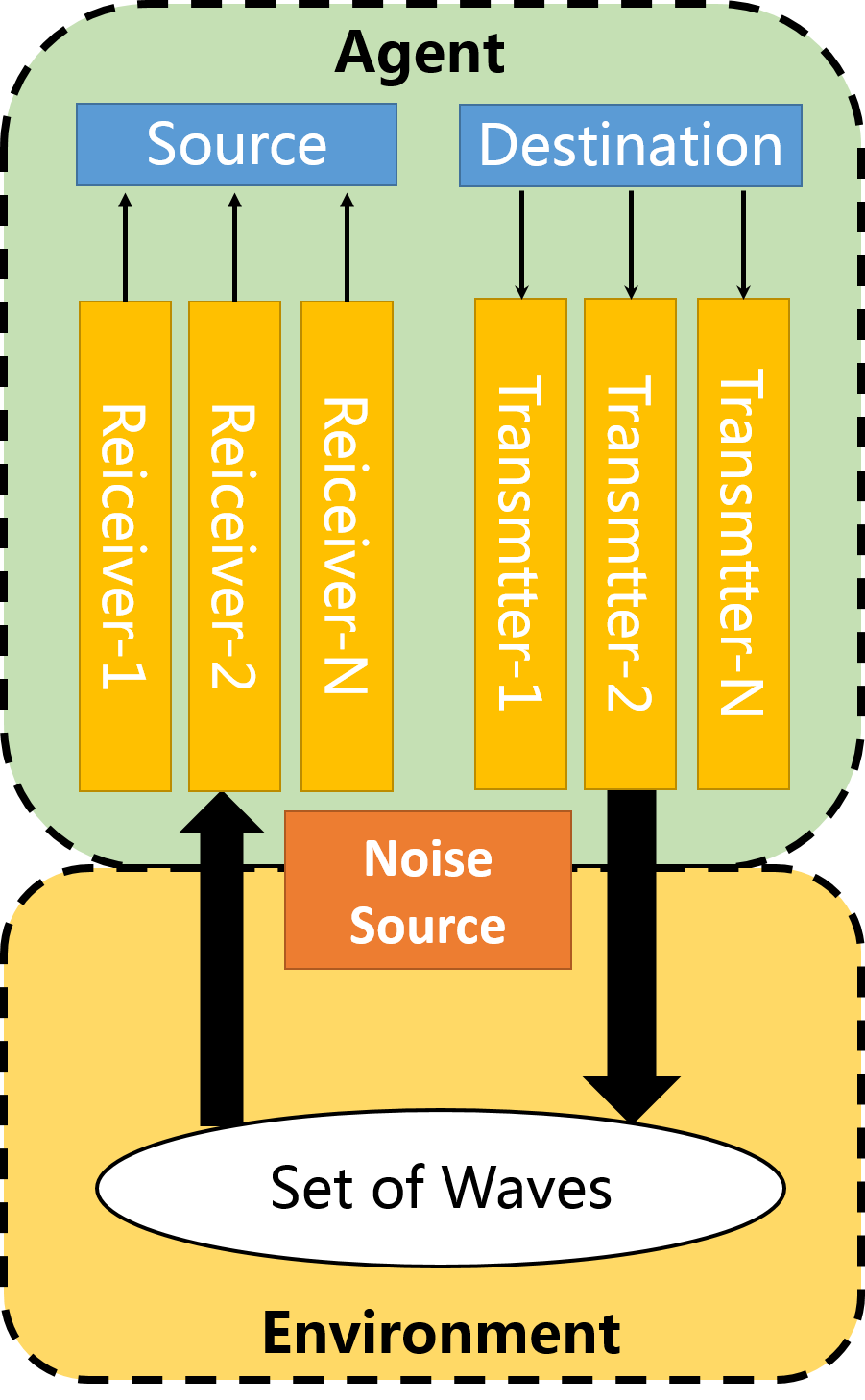An Unified Intelligence-Communication Model for Multi-Agent System: Overview and Case Studies -- Chapter One: A Brief Introduction of the UIC Model - From Shannon's Perspective
This paper would be fully open-access. The arxiv preview version is available @ arxiv page
My handwriting manuscript is prepared, and I am currently crafting it into a rigorous research treatize.
This Chapter introduces the motivation of the UIC model and the basic graphical description of the UIC model, illustrating the relationship between an intelligent agent and the environment. This chapter would cover the following aspects.
- The environment is modelled as the generic communication channel between agents.
- The agent is modelled as an communication transceiver:
- The internal world model is modelled as a source coder, which encodes the environment.
- Multi-modal perceiving and acting capability are abstracted as multiple transmitter-receiver pairs.
Further insights of the UIC model, as proposed in the outline of this paper, would be discussed in depth in the following-up Chapters.
A Brief Review of the Shannon Model
This section applies the Shannon Model to describe complex forms of interactions between agents and environments.
The Shannon model proposed in the pioneering paper “A mathematical theory of communication” may be illustrated as follows, and please note that the Weiner’s feedback is not included for now.

Figure 1. Shannon Model without Feedback
Complex Interactions Modeling: Is Shannon Model Sufficient?
This paper is definitely NOT the first effort to apply Shannon Model to model and understand the interactions between agents and the environment.
An intuitive question arose immediately (especially the critics from the communication society and most of the control society) and therefore may prohibit the further efforts. Is the Shannon model sufficient to capture complex interactions between agents and the environment? As an agent not only transmits and receives waveforms, but also changes the physical environment, e.g. moving objects, absorbs solar energy, etc.
Before answering the above question directly, the author may redirect to a more fundamental question: What is the relationship between Information, Substance and Energy? The answer to this question may help determine the range of applications of Shannon Model. Hence, the UIC model may be firmly built based on the following statements.
- Information is carried by waves. The waves may be electromagnetic waves, mechanical waves, matter waves and other forms of waves, which are generated by the four fundamental interactions.
- The environment may be modeled as a possibly infinite set of waves. Each wave carries a certain amount of information and energy. The different forms of waves may interact, exchanging energy and information.
- Any form of interactions may be contaminated by noise or uncertainty. Therefore, the maximum amount of information that may be transferred by a wave is quantified by the Shannon Channel Capacity.
Based on the above statements, we may come to the following statements:
The environment may be modelled as a set of multi-modal channels for different forms of waves.
The Agent Model in the UIC Model
After modelling the environments, and based on the widely adopted philosophy that an intelligent agent is an open system in the environment, the UIC model incorporates the most important assumptions of an intelligent agent:
The UIC Assumption: As with the Environment, an agent is also a set of waves, and the interactions between an agent and the environment may be modelled as interactions between waves. The interaction process exchanges energy and information, meanwhile incorporates uncertainties.
Therefore, the interactions between an agent and the environment may be categorized by the widely used terminologies in describing the behaviour of an intelligent agent:
- Perception: perception may be considered as the measurement of energy and information carried by a wave in the environment.
- Based on the UIC Assumption, perception is modelled as the energy and information transferring from the environment to the agent.
- The perception module of an agent is then modelled as a set of channel receivers, where each receiver extracts information from the waves, and an optimal receiver extracts the maximum amount of information, as bounded by the Shannon Capacity.
- Action: action taken by an agent may be in the macro and micro level, and in various domains, e.g. spatial, frequency, energy, etc.
- Based on the UIC Assumption, any action may be modelled as a form of wave interactions, action is modelled as the energy and information transferring from the agent to the environment.
- The action module of an agent is then modelled as a set of channel transmitters, where each transmitter modulates a certain set of waves with information, and a feedback from the receiver, as shown by Shannon and Wiener, may greatly improve the optimal transmitter-receiver design.
We may now graphically depict the first UIC model figure, focusing on using the Shannon model to interpret the interactions between the agent and the environment.

Figure 2. Interactive Model between the Agent and the Environment
In the up-coming chapter, we will dive deeper into the information source and destination in the agent.
References
[1] Shannon, Claude Elwood. “A mathematical theory of communication.” Bell system technical journal 27.3 (1948): 379-423.